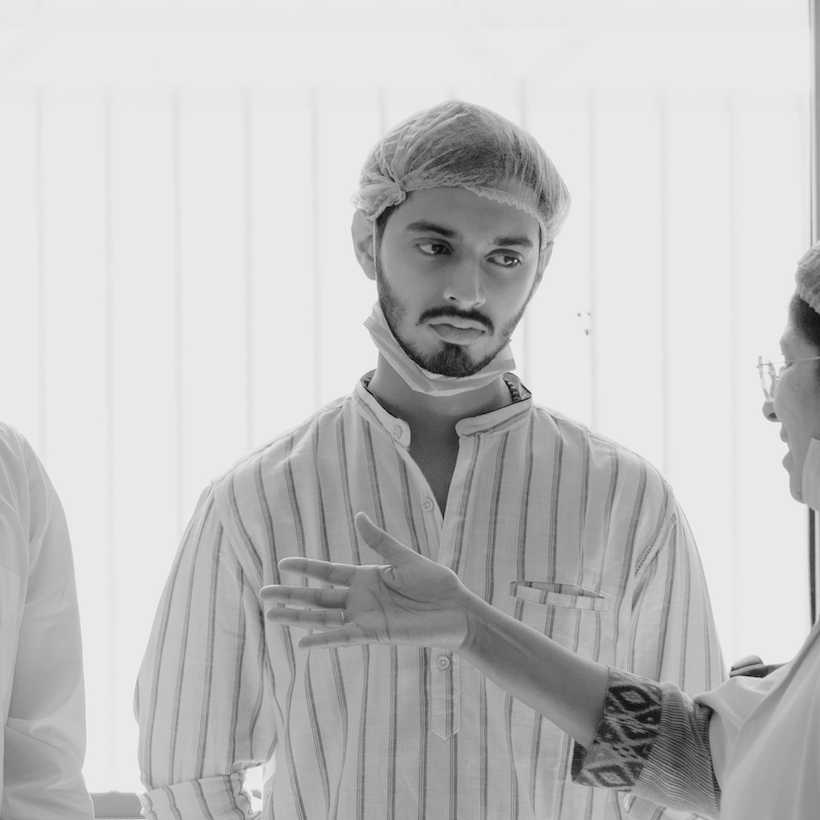Meet the misfits - Research Team

Param Barodia
Bringing a generalist mindset with varied academic experience, Param spends his days tinkering with brain-computer interfaces and exploring neuroscience. When he’s not busy trying to merge minds with machines, Param enjoys his coffee while brainstorming how AGI could be the next step in evolution. Param is here to push boundaries and have some fun along the way.

Heth Joshi
Heth enjoys exploring how a different perspective of life leads to a different experience of it. With a clinical background and a creative mind, she strives to understand things most of us miss. Always up for understanding other people, and she is up for a conversation. She aims to understand the human mind better, both at a microscopic and psychological level.

Krishna D Thaker
Krishna with her electric personality, she indeed does focus on electronics and singaling. If you ever smell soldering in the lab, she definitely has her hands full with a new innovation. Designing and planning the tech essential in leaps of neuroscience into the future, she always thinks outside the circuit. With a passionate heart and masterful skills, she is a true researcher.

Bharath
Bharath has always been fascinated by the human mind, with a background focusing on both medicine and technology, he is eager to crack the code on how our brain works. From making the lab laugh with his one-liners, to pin drop silence when he pitches his ideas, he is the balance we all strive for.
Misfit Research Archive
BiASE: Bidirectional Arrhythmia Sequence extractor
Edition: Volume 12 Issue 7, Medical Research Archives
Abhijeet Satani | Param Barodia | Dr. Bhoomi Satani
Abstract: Identifying Arrhythmia for healthcare professionals is critical, considering time and effort and existing struggle with complex spatial and temporal artifacts. The current Machine Learning focuses on accurate classification instead of having a deeper lookat the signal origination and cause of disease. Addressing these issues, this paper presents Bidirectional Arrhythmia Sequence extractor, a unique deep learning model for Electrocardiogram -based arrhythmia classification. The three main parts are: 1) a Squeeze-and-Excitation Temporal Attention Module to model long-range temporal dependencies; 2) a Multi-Receptive Convolutional Module to extract spatial patterns at multiple scales; and 3) an Adaptive Class-Balanced Loss to minimize class imbalance.
The combination of using Multi-Receptive Convolutional Module and Squeeze-and-Excitation Temporal Attention Module helps the classification and identification of these electrocardiogram signals considering both the spatial and temporal factors and also use of Adaptive Class-Balanced Loss todynamically adjust class weights during training to emphasize underrepresented arrhythmia types. The proposed Bidirectional Arrhythmia Sequence extractor architecture advances electrocardiogram arrhythmia classification by learning discriminative spatio-temporal representations while handling data challenges. Bidirectional Arrhythmia Sequence extractor can improve clinical decision support and heart disease diagnosis.
Innovative Approach: Facial Recognition and Event-Related Potential for Early Detection of Alzheimer’s Disease
Edition: Volume 13 Issue 5, May 2024, Pages: 1156 – 1163
Abhijeet Satani | David Kaiser | Param Barodia
Abstract: Alzheimer’s disease frequently causes impairments in facial recognition, leading to significant consequences for patients’ social well-being. In this study, we employed electroencephalography (EEG) and experimental methods to investigate how facial processing differs between AD patients and a healthy control group. Distinct face processing characteristics were associated with various Event-Related Potential (ERP) components, including N170, N250, and N400.
The AD patient, PATIENT(A), exhibited a reduced N170 for faces compared to houses and scrambled objects, suggesting deficits in encoding face-specific configurations. Moreover, facial recognition impairments in PATIENT(A) might be attributed to specific difficulties in processing face configuration, as evidenced by the absence of the typical inversion effect at the neuronal level. Additionally, fear facial expressions elicited a disproportionately large N170 response, indicating that emotional stimuli may be processed implicitly. Familiarity manipulation did not modulate the N250 in PATIENT(A) but did reveal a clear modulation of the N400 component, suggesting that long-term memory traces may be implicitly preserved.
This study demonstrates the potential for advancing scientific understanding of face processing deficits in AD through the combination of in-depth individual case studies and electrophysiology. The findings highlight the importance of using electrophysiological markers in clinical practice to improve patient management, classification, and the development of targeted rehabilitation protocols for face processing deficits in AD patients.
Effects of Spirituality on Neural Pathway in the Brain
Edition: Volume 13 Issue 2, February 2024, Pages: 1 – 5
Abhijeet Satani | Param Barodia | Dhrumil Bhanderi
Abstract: This research delves into the profound impact of Sanskrit and Hindu mantras on the human brain, exploring neurological changes associated with the vocalization of Sanskrit. A multidisciplinary approach involves 108 pandits, two patients, and 12 volunteers participating in yagna rituals. This comprehensive study employs EEG measurements, psychological assessments, and qualitative observation to uncover the mantra?s cognitive imprints on the brain. The finding offers compelling evidence of brain activity among pandits, suggesting the mantra?s potential influence. The discussion highlights the mantra?s unique qualities and its role in shaping neuroplasticity, enhancing cognitive skills, and sharpening attention. In a broader context, this research contributes to an evolving base where spirituality converges with neuroscience.
In conclusion, this study fills a gap in understanding the effect of mantras, shedding light on the profound connection between spiritual practices and human well-being. Future investigations in this domain hold the promise of further unravelling the relationship between faith and science.
